Lecture
Pose (from French pose via German, previously from Latin pono (supin positum) “to put, to place” ) is the position taken by the human body , the position of the body, head and limbs in relation to each other.
In a figurative sense, “ pose ” is pretense, insincere behavior, or posing: for example, “to strike a pose” means to take a deliberately effective position.
Postures are studied by biomechanics, physical culture and physiology. Posture is usually maintained by the balance of body segments, tonic tension of muscles supporting joint angles and interaction with the support.
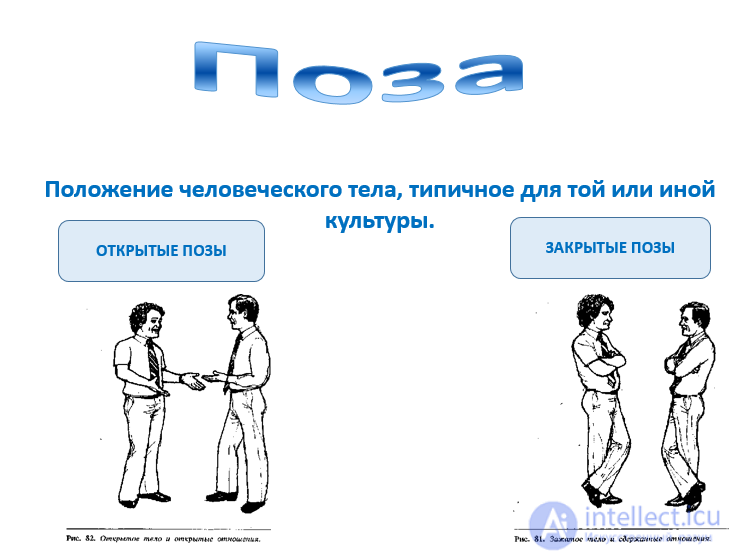
The pose is characterized by relative immobility, as well as the orientation of the spine relative to the horizon and the supporting part of the body . The main human poses are: vertical (orthograde) - with support on the feet (standing pose), with support on the buttocks (sitting pose) and horizontal with support on the back (lying down), on the hands and knees (on all fours).
| Support | |||||||||
|---|---|---|---|---|---|---|---|---|---|
| Spine orientation | Feet | Buttocks | Back | Head | Hands | Knees | … | ||
| Vertical (orthograde) | head up | Standing | Sitting | ||||||
| head down | |||||||||
| Horizontal | back down | Lying down (on your back) | |||||||
| back up | On all fours | ||||||||
| on the side | |||||||||
| Inclined | head up | ||||||||
| head down | |||||||||
Regulation of posture (postural regulation) is complex and involves various levels of the central nervous system, and in the case of voluntary changes in posture, the cerebral cortex. The sense of posture is proprioception.
In both humans and animals, posture can express emotions . Emotions are also conveyed through posture in art - ballet, sculpture, painting. Particular importance is given to posture in sports (including martial arts), in health systems (for example, in yoga) and in medicine.
The term “pose” is associated with a number of rather complex concepts from the field of physical education, physiology and human biomechanics: body position, posture, standing, walking.
Synonyms for the word pose:
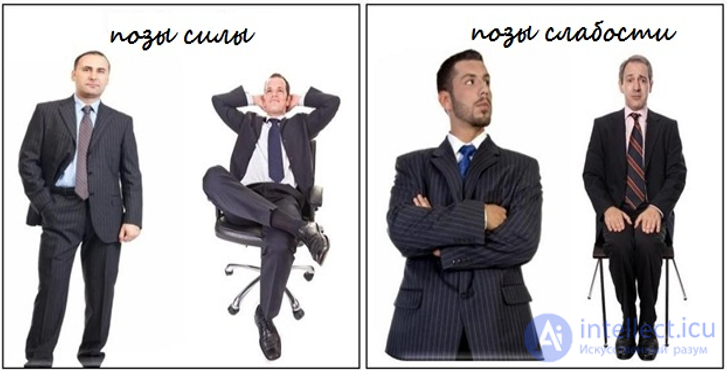
There are also such separate concepts as: “working posture”, “sports posture”...
The concepts of "posture" and "carriage" are often confused. Both of these concepts characterize the position of the human body. A person, under the influence of external circumstances or by an effort of will, can take any pose (available to his musculoskeletal system). However, posture is the habitual pose that is determined reflexively, by the so-called motor stereotype - a complex of unconditional reflexes, as well as skeletal and muscular balance.
From the point of view of physiology and biomechanics, posture and bearing differ as follows:
As follows from the definition of posture, we are talking only about the usual, vertical pose. Posture is one of the characteristics of posture.
A pose is a “frozen” movement, while posture is a “living” pose that changes over time (postural sway of the body when standing, the position of body segments when walking, etc.)
Posture is a characteristic of any animal, and bearing, being a product of upright walking, is characteristic only of humans.
Synonyms:
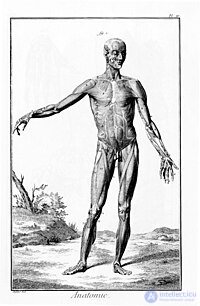
In the process of human evolution, one of the most expedient and stable dynamic systems was formed - the functional antigravity system. From the first hours of his intrauterine development, a person exists in the conditions of the Earth's gravitational field. In order to constantly counteract the gravitational factor and compensate for undesirable shifts in the body, diverse vestibular-motor, vestibular-visceral-vascular and vestibular-oculomotor reactions are carried out, quickly adjusted to the current situation .
Maintaining an upright posture, standing upright and walking upright is one of the main features of human adaptation to existence in the Earth's gravitational field. Maintaining an upright posture absorbs the features of a person's constitution, integrates his life experience and partly demonstrates the functional and pathological features of a specific individual. The orthograde body position characterizes such human motor actions as standing, walking, running and other types of motor activity.
Orthograde posture is the most studied and studied by many sciences, such as anatomy, biomechanics, physiology, medicine, posturology, physical education, human position. Orthograde posture is associated with an important biomechanical parameter of a person, called "posture".
Synonyms:
The standing posture is the main characteristic of such important human motor acts as standing and walking.
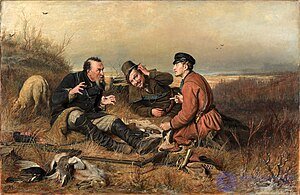
Vasily Perov. "Hunters at Rest"
A position for resting or performing any action with support on the "fifth point", on the buttocks or thighs, in which the body maintains a vertical position (sitting).
There is also a more scientific definition of this pose:
"A body position in which the body weight is transferred primarily to the ischial tuberosities of the pelvis and the underlying soft tissues"
(eng.)Sitting is a body position in which the weight of the body is transferred to a supporting area mainly by the ischial tuberosities of the pelvis and their surrounding soft tissue
There are many types of seating:
The sitting posture is characterized by the angle formed by rays drawn from the lower part of the sternum to the plane of the face and to the bend of the knee joint. This angle is called the angle of inclination of the trunk.
Depending on the angle of the body, a distinction is made between:
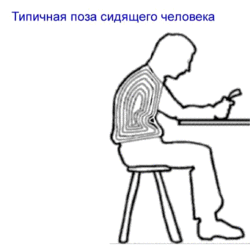
The pose is comfortable, for example, for office work, but in itself is a difficult test for the human skeleton and internal organs.
A slouched sitting posture is characterized by maximum flexion in the lumbar and thoracic spine and a forward tilt of the torso.
This posture has a number of adverse biomechanical and physiological consequences:
Also, a slouched posture is caused in schoolchildren when working at a table that is too low, since the table and chair should correspond to their height.
The sitting posture is studied by the science of ergonomics (in Russia - occupational hygiene). Ignoring hygiene requirements, violating safety precautions for sedentary work leads to a number of chronic diseases. The leading symptom is a slouched posture as a result of a habitual posture with a "collapsed" back.
Bad posture, according to the classification of some European countries, is an occupational disease of office workers. This category also includes drivers of cars that are not equipped with modern seats in accordance with hygienic requirements. As is known, osteochondrosis of the spine, neck and lumbar pain, prostatitis, hemorrhoids are problems not only of accountants, programmers and economists, but also of truck drivers.
A general medical term for pain in the sacrum or tailbone. Coccydynia limits comfortable sitting on a chair, leading to a forced posture with support transferred to one of the buttocks.
This position is the least studied due to the low interest of researchers in this form of motor activity. The lying position is the most energy-efficient. It is used in the study of the basal metabolic rate (the amount of energy needed to maintain normal body functions with minimal metabolic processes). If a person lies completely still for at least 12 hours after eating, then the energy used at any given moment is spent on the work of the heart, breathing movements and maintaining body temperature
The following poses are distinguished:
and also sports racks:
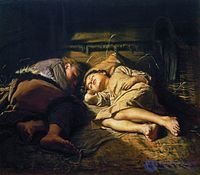
V. Perov Sleeping Children
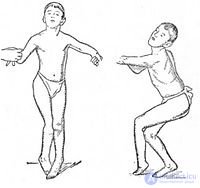
A posture caused by a muscle tone disorder, characteristic of cerebral palsy

Posture caused by contracture of the hip joint in coxarthrosis
Pathological posture is a characteristic posture resulting from dysfunction of muscles and joints due to diseases of the nervous system and musculoskeletal system. For example, the posture in cerebral palsy (CP), the posture resulting from contracture of the hip joint in coxarthrosis, the flexion posture in ankylosing spondylitis, the posture in torticollis. Some pathological postures have figurative names: "pointer dog posture" (meningitic) - a posture characteristic of the acute period of meningitis, in which the patient lies on his side with his legs bent and brought to the stomach; frog posture - a posture characteristic of hereditary spinal amyotrophy, in which the arms are bent at the elbows, and the legs at the knee joints, the shoulders are brought to the body, the hips are abducted .
There are known poses of joy, openness, calmness, sadness, confusion, etc., reflecting the internal state of a person.
A person's emotions and his body are inextricably linked, and changes in one entail changes in the other. Emotions change muscle tension. Changing the position of the body can change the emotional state.
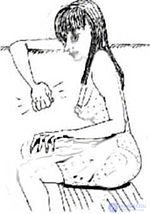
Passive defensive posture
The English researcher, Charles Darwin, in his book (1872) “The Emotions of Men and Animals” convincingly states: “Certain movements and attitudes (sometimes to a great extent) are capable of evoking corresponding emotions… Take a sad attitude, and after a while you will feel sad… Emotions induce movement, but movements also induce emotions .” For example, in response to negative emotions or fatigue, a person reflexively, as a result of an innate behavioral instinct, takes the so-called passive-defensive attitude .
The passive-defensive posture is characterized by raised and hunched-forward shoulders, a lowered and forward-thrust head, and a hunched back. With frequent repetition, such a posture can become and often does become habitual, fixed in the motor stereotype of posture .
Primary positional disorders in adolescence deserve special mention. Thus, young men and women, under the influence of various psycho-emotional complexes, deform their posture - they push both shoulders forward and "hunch over". As a result, a cyclical restructuring of muscle groups is launched and pathological posture is formed. Bad posture, in turn, contributes to the consolidation of psycho-emotional disorders and the formation of neuroses.
Many diseases of the psycho-emotional sphere (neuroses) are associated with poor posture. Chronic fatigue syndrome is the most common disease of modern man (it is also called neurasthenia, vegetative-vascular dystonia). The most common symptom of neurasthenia is a feeling of constant fatigue, headaches, dizziness, rapid heartbeat, etc. People suffering from neurosis are always "tensed", they are characterized by uneven muscle tension and poor posture. A person is able to consciously correct the usual posture and the manner of movement developed over the years, and thereby get rid of existing problems. For example, this is the basis of the Frederick Alexander method and other methods of psychosomatic correction, which help to effectively relax muscles and relieve excess tension.
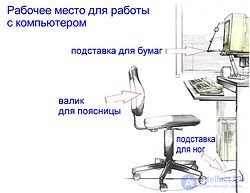
work place for working with a computer
Working posture - the relative position of body parts when performing a work operation - is studied by the science of ergonomics (occupational hygiene).
Working positions are divided into free, uncomfortable, forced and fixed.
Nowadays, more and more attention is paid to the ergonomics of office work and school teaching postures.
When doing schoolwork, children are usually forced to maintain working positions for a long time, which often do not correspond to normal physiology. After school starts, the amount of time a child spends in a sitting position increases significantly, and the school desk becomes an important environmental factor. It is generally accepted that it is most convenient to do homework while sitting at a table [11] [12] .
In sports and physical education, a distinction is made between the concepts of “body posture” and “body position”.
When performing gymnastic exercises, the following postures are distinguished: arched; bent; in a group; wide stance with legs apart; a lunge with a tilt; basic stance with arms to the sides, forward, on the waist, etc.
Body positions are divided into vertical: stands (basic, on the shoulder blades, on the head and hands), hangs and supports; horizontal (lying on the stomach, on the back, horizontal balances); inclined (support lying behind, inclined lunge, etc.).

Starting positions in Swedish gymnastics

Basic stance: 4 points in a single plane: the back of the head, shoulder blades, buttocks and heels, hands extended, chin down, head back
Some physical exercises are performed without changing the position of the body and posture while arbitrarily maintaining a motionless state of the body in the somatic frame of reference (stance in a straight line movement when skiing, balance, body position when jumping from a height, etc.).
When performing most physical exercises, the body position and postures are constantly changing. Only the positions can change while maintaining a given posture (a straight body during a back swing on the horizontal bar, maintaining a grouping during a series of acrobatic somersaults, etc.); only the posture changes while maintaining the position (squatting and standing up, walking, running evenly in a straight line, etc.); both positions and postures change (performing a long somersault; high jump in various ways, a throw-over; a rise with an extension on the bars; a starting run-up, etc.) [13] .
Each exercise has three phases:
Initial position (IP) is the most comfortable position for performing a physical exercise or other motor action. Most often in physical education, the IP is the basic stance , but before performing some exercises, it is necessary to adopt other IPs: kneeling, half-squat, squat support, lying support, lying on the stomach, side or back, hanging, etc.
The basic stance is a position in which the legs are straightened at the joints, the body is straightened, the head is held straight, the gaze is directed forward, the arms hang freely to the sides. The usual position of the feet is "heels together, toes apart". For example, D. Kradman (1928) described the basic stance in Swedish gymnastics as follows: "4 points in a single plane: the back of the head, shoulder blades, buttocks and heels, the hands are extended, the chin is lowered, the head is back."
Men perform floor exercises from the basic stance. Women perform them from the position of feet shoulder-width apart, arms down. Vault is performed from the basic stance.
The athletes perform the exercises from the same position as the floor exercises. In doing so, they work with different objects, which they hold in the appropriate position.
In wushu taolu gymnastics, athletes take the same position as in floor exercises. When performing exercises, an athlete can take a fighting stance.
In figure skating, men and women take the usual pose: left skate straight, right skate on the toe, leg bent. Pairs take the appropriate pose depending on the discipline: in pair skating, athletes either take the same position as in single skating, or the partners hold each other by the hands or body, in dance, the partner can hold the partner in a horizontal pose. When performing spins and step sequences, the pose is different; during the step sequence, the left leg is slightly bent, the right is straight. The spin before the end of the program is performed in a squat, after which the skater slowly rises.
Short and middle distance running starts from the starting blocks. At the command "on your marks!" the athlete takes the appropriate position; rests his hands on the starting blocks, legs bent at the knees. After the command "attention!" the athlete sharply raises his body back. After the starting signal (shot or command "march!") the runner pushes off from the blocks and vigorously waves his arms. In race walking the athlete must ensure that there is no flight or jump, as in running (otherwise the athlete is punished with a warning or disqualification). In long jump and triple jump there are three positions: "bend", "scissors" and "crouched". High jump is performed from the basic stance. Pole vaults are also performed in exactly the same position, with the arms raised to the shoulders, holding the pole in such a position as to easily push off during the run. The discus thrower and the hammer thrower stand in the position of the left leg straight, the right half-bent. The javelin thrower throws the projectile from the basic stance; the left hand is lowered, the right with the javelin is raised up. During the throw, the athlete, having run up, slightly bends the right leg forward and throws the javelin with sharp movements. In shot put, the pose is the same as in weightlifting.
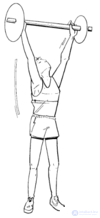
Fixing the barbell lift

Back Squat in Powerlifting
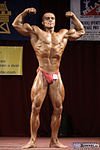
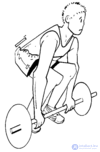
Deadlift
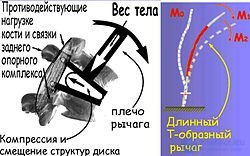
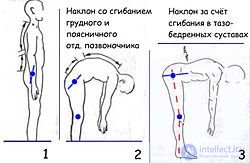
Posture in strength sports, which include: weightlifting (barbell), bodybuilding (power gymnastics), kettlebell lifting, powerlifting, reflects their internal content.
Weightlifting is a competition in lifting weights (barbells) while performing certain standardized exercises: snatch, clean and press. The posture in weightlifting is associated primarily with fixing the lifting of the barbell, a motionless position of the athlete with the barbell over his head on straightened arms, legs and torso straight, feet on one line, parallel to the bar, determined by the rules of the competition [15] .
Kettlebell lifting is, first of all, a mass sport, a sport without age or functional limitations, a sport for strong people.
Powerlifting includes 3 exercises: squats with a barbell on the back, bench press on a horizontal bench, and deadlift.
The following provisions are recorded:
Bodybuilding is, first of all, the sculptural beauty of the body. At bodybuilding competitions, athletes demonstrate, using spectacular poses, muscle relief, and correct body proportions.
Performing exercises involving lifting weights is dangerous. The greatest danger is lifting weights in a forward-leaning position (deadlift). This body position is associated with possible overload of the lumbar spine and a high risk of spinal injury due to errors in the technique of the pull. The greater the forward lean, the less load on the legs, and the more on the back.
Typical mistakes when performing deadlifts:
Biomechanics of the Forward Bend Pose
Forward bending of the body is always associated with excessive loads on the thoracic and, to a greater extent, on the lumbar spine. This load is counteracted by the bones and ligaments of the posterior support complex of the spine, as well as the elastic resistance of the compressible and displaceable structures of the intervertebral disc - the anterior support complex. If in the vertical stand position the body weight is evenly distributed on the posterior and anterior support complex, then when bending the body forward, two body position options are possible:
Flexion of the cervical spine (head tilt forward) due to the cervical postural tonic reflex facilitates flexion in the lower parts of the spine, and extension (head position straight) makes flexion of the spine impossible. In fact, this phenomenon is used by powerlifters and weightlifters when performing deadlifts in order to avoid overloading the lumbar segment.
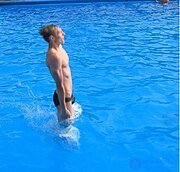
Jump into water. Vertical entry into water with feet
In competitive swimming, the starting position or the jump into the water is fixed, and in diving, the pose of entering the water is also fixed. In diving, a distinction is made between the pose of the starting position (jumps from the front and back stances, from a handstand) and the pose of vertical entry into the water (head or feet) [17] .
At the start, a skier and a biathlete take the appropriate position depending on the style. In a classic style race, the start is taken from the basic stance. Biathletes mainly move in a free style, with this method of movement, the legs with skis are placed apart, the toes are pointed, the arms with the poles are also slightly pulled. In a sprint race, skiers start in the same way as runners. At the finish, the athlete, after crossing the finish line, turns his legs to the sides so as not to touch the poles. Shooting in biathlon is done from a prone and standing position. When shooting from a prone position, the athlete lies on a special mat on his stomach, holding the rifle with outstretched arms to make it more convenient to shoot. When shooting standing, the right leg is placed forward, the left leg is slightly raised behind on the toe. The athlete holds the rifle with outstretched arms closer to the right shoulder.
In shooting sports, athletes take the same position as biathletes. Archers lunge forward when shooting to make it easier to pull the bowstring, with the arrow in the appropriate position. In clay pigeon shooting, the athlete's head is raised so that it is easier to shoot at flying discs.
In football, before the start of the match, the teams take the basic stance. When taking a penalty, a football player swings his right leg back from the basic stance, then kicks the ball with the same leg. A basketball player also throws from the basic stance, with his hands holding the ball forward. When throwing, his hands rest lightly on the basket. In volleyball, when serving, the legs are extended apart, the left arm is extended forward, the ball is in the palm, and the server hits the ball with an open palm with his bent right arm. When blocking, athletes extend their arms forward and upward, while standing closer to the net. Hockey players move along the ice leaning slightly forward to get a better view of the puck.
The pose in martial arts is distinguishable.
When entering the ring, boxers take the basic stance (one athlete is in the red corner, the other in the blue). Before the start of the fight, the athletes take a fighting stance. If an athlete takes a stance before the count of "nine" during the fight, the fight continues. If he cannot do this, the referee says "ten" and the fight is considered finished by knockout.
The wrestlers take the position of the left leg behind, the right leg in front, then, having started the fight, change the position of the legs. Then they straighten their legs.
In oriental martial arts, the pose is the same as in wushu. When performing a strike, the athlete slightly bends one leg and strikes the opponent with the other.
Various positions for intercourse are described in many sources of different cultures, from ancient times to the present day. All heterosexual positions can be conditionally combined into several large groups: man on top, woman on top, man from behind, cross positions, side positions, sitting and standing positions, as well as mixed positions, such as the "boat" position, and athletic positions that require additional dexterity and, in part, special physical training.
Man is the main and fundamental theme of fine art. The creation of a generalized image of a perfect man, beautiful physically and spiritually, is characteristic of the art of the High Renaissance.
Game: Perform tasks and rest cool.7 people play!
Play game
The artist who first raised the image of man to such a height was Leonardo da Vinci. His work combines the inquisitive analytical spirit of the early Renaissance with its comprehensive interests and the powerful desire for synthesis, order and norm characteristic of the 16th century. Everything attracts Leonardo's attention, but the main object of study and the main goal of all the artist's efforts is man. With the greatest care he studies the internal structure of man, his proportions and vital functions, striving on the basis of this analysis to establish certain objective patterns and give general rules for artists. Not content with the depiction of one external appearance, Leonardo peers with lively interest into human faces, trying to find a connection between a person's experiences and their external manifestations, striving through the wealth of gestures and the play of physiognomy to convey the internal spiritual state.
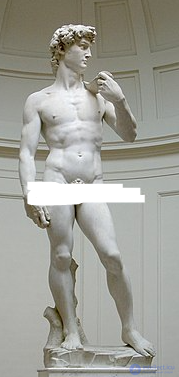
Michelangelo. Statue of David, 1500-1504. A standard of natural pose
Another famous master of that era, Michelangelo, also creates an image of the perfect man. His "David" is full of internal dynamics, expression, energy and realism [18] .
The natural majestic beauty of Renaissance figures, without excessive mannerism of gestures and poses, the clarity of proportions and forms of the human body make these works of art a standard of body position for physiologists and biomechanics. Thus, Michelangelo's sculpture is a common illustration of natural pose and posture.
Natural posture (posture) - a posture with predominantly one leg - the so-called pose of a sculptural image. The supporting and non-supporting leg change after a short period of time, as a result of which fatigue does not occur so quickly.
When depicting a person, Renaissance masters used various technical methods, the main one of which was contrapposto , introduced in the 4th century BC by the ancient Greek sculptor Praxiteles.
Contraposto is a technique in fine art in which the position of one part of the body is contrastingly opposed to the position of another part. Contraposto allows one to convey the movement or tension of a figure without disturbing the impression of its balance, gives additional volume to the image, and dynamizes the rhythm of the figure.
The natural posture is opposed to the anatomical (anthropometric) position of the body - the standard posture used for the study (also called the Forestier posture): in the vertical position, the body weight is evenly distributed between the right and left legs. With correct posture, we see a symmetrical position of the head and body, the legs are straight, the shoulders are relaxed, the shoulder blades are pressed to the body, the chest is symmetrical.
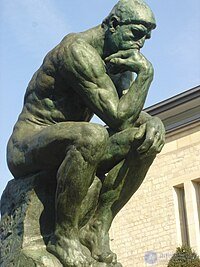
Francois Rodin. The Thinker, 1880-1882

Victor Vasnetsov. Alyonushka, 1880—1881
Later, the importance of pose in fine art increased. The pose conveys not only the harmony of a person, his physical and spiritual beauty, but also his inner state, aspirations, dreams. Such is the famous "Thinker" by Francois Rodin, who, according to the artist's conception, depicts Dante at the gates of Hell, composing his "Divine Comedy". The sculpture became one of the most recognizable in the mass consciousness, a symbol of the power of the human mind, the expression "pose of the thinker" became a household word.
In the same year of 1880, the Russian artist Viktor Vasnetsov began work on the painting "Alyonushka", which was later called by the famous critic I. E. Grabar one of the best paintings of the Russian school. In the pose of Alyonushka, in her hunched figure, evoking immense pity, in the touching thinness and girlish awkwardness of her entire appearance, Vasnetsov expressed what many Russian songs and fairy tales have been composed about over the centuries.
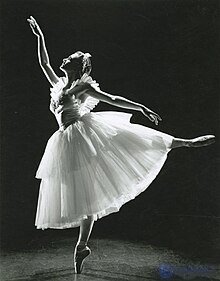
Ballerina in I arabesque pose on toes
Ballet is often called the art of poses. Both in a classical dance lesson and during a stage performance, dancers adopt various poses, alternating them with each other and with other elements - jumps, turns and various dance pas (pas). A pose in classical dance is understood as a stop in movement, during which the dancer's body is in a position of balance on one (supporting) leg, while the other (working) is moved forward, to the side or back on the toe on the floor or in the air, as well as fixing such a position of the arms and legs at the maximum point of the jump or in support.
Classical ballet, which emerged in Europe in the 15th-16th centuries as a courtly and aristocratic art, emerged as a result of the theatricalization of everyday dances performed at balls and festivities, which involved the participants performing figures and changing poses to music. With the development of classical dance, many movements became more complex and modified, but the pose, as a fixation of the harmonious position of the body, remained one of the main elements of ballet art.
The basic poses of classical dance include:
(*) These poses are divided into croisée [* 5] and effacée [* 6] , and can also be performed en face [* 7]
Basic poses can be divided into small (the working leg is on the floor), medium (the working leg is raised above the floor) and large (the working leg is raised high in the air).
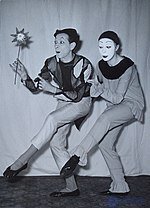
Classic French pantomime
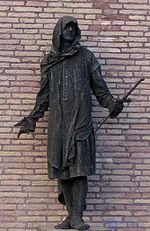
Mime on the street in Rome
Pantomime, as a separate genre of art with its own attributes (taboo on the speech of characters; actors' faces painted white; a specific wardrobe), appeared in Paris at the beginning of the 19th century and has since become a traditional European folk theatre genre.
The poses of the actors in pantomime are a key element of the performance. With the help of poses, the actor can convey the state of his character, interact with the space surrounding the character, including imaginary, "invisible" partners and objects. Also, in short comic scenes, the actors themselves can depict various objects familiar to the viewer (a kettle, an iron, a radio, a bottle of champagne, etc.).
There are a number of games in which participants take turns guessing the intended objects by depicting them using poses and actions.
There are several directions in modern pantomime; actors often strive to move away from the classic image of a clown-mime, making changes to their artistic image.
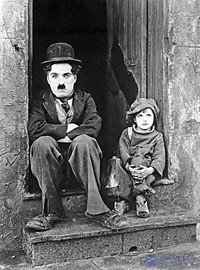
Charlie Chaplin and Jackie Coogan in The Kid (1921)
The importance of poses taken by actors was extremely high in the silent film era. In the absence of sound, poses were one of the few expressive means, especially before the use of close-ups, which brought facial expressions to cinema. To compensate for the paucity of expressive means, the following techniques were used:
Coloring and toning of film or its fragments was also sometimes used.
Among all these expressive means, pose was the most important for that time. By means of hyperbolized, sometimes fanciful poses, the hero's experiences and passions that overwhelmed him were conveyed to the viewer. Thus, tragic or simply sad events could be accompanied by the hero falling to his knees, picturesquely wringing his hands, raising them to the sky. Joyful events, on the contrary, forced the heroes to embrace, start dancing, etc. In this sense, silent cinema was close to the art of pantomime. The mime technique was used, in particular, by comedy writers and comedians of silent cinema: Charlie Chaplin, Buster Keaton, Harold Lloyd and others.
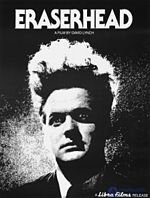
"Eraserhead" by David Lynch
After the advent of sound in cinema, and later of color, the need for theatricalization of the visual series disappeared. Cinematography became increasingly realistically oriented, the deliberate expression of poses and movements of heroes remained only in the works of some avant-garde authors (see, for example, David Lynch's film Eraserhead, whose heroes are in unnaturally constrained poses).
At the same time, various cliches appeared in genre cinema, some of which are directly related to the poses of the heroes. As an example, we can cite classic westerns, in which duels take place between the heroes - cowboys and gunslingers.
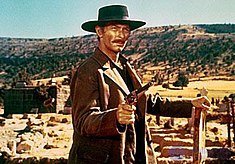
Still from Sergio Leone's spaghetti western The Good, the Bad and the Ugly (1966)
The pose of the hero, closely watching the enemy's actions, is extremely expressive, the camera angles are maximally effective, the tension simply hovers over the scene. Such episodes are especially characteristic of the so-called spaghetti westerns of European production.
Another example is the "zombie pose." The living dead walk slowly, sleepwalking, with their hands limply held in front of them, and their head turned or tilted slightly to the side. This stereotype became popular after George Romero's 1968 film Night of the Living Dead.
In general, cinema has given rise to many poses that have become characteristic of fictional or supernatural creatures: ghouls, vampires, werewolves, etc. For example, in the 1973 film The Exorcist, the body of a girl possessed by an evil spirit, during "attacks" takes on completely unnatural, and sometimes impossible poses.
Martial arts films occupy an important place in Asian cinema. The heroes often have supernatural powers, and during fights their bodies do not obey the laws of physics. They can take spectacular, but sometimes aimless poses that have a purely aesthetic value: see, for example, Crouching Tiger, Hidden Dragon, Hero (2002), various anime.
Often the reason for such behavior of heroes is their mythological or semi-legendary nature. In most cases, in modern cinema, characteristic, recognizable poses are inherent in characters in relation to whom some stereotypes are formed in the minds of the majority or beliefs and prejudices are strong. It is in this idealized form that modern Europeans see the shooters of the Wild West, and the Chinese or Japanese their ancestors. Cinematic poses of heroes are a reflection of this perception. In Soviet cinema, any pose is characteristic. So in the film "The Diamond Arm", the hero of Andrei Mironov Gesha Kozodoyev lies on the board on his stomach and then gets into the pose of an athlete, holding the fishing rods on outstretched arms and in this pose shouts "Help! Save! SOS!" In the film "Guest from the Future" Kolya Gerasimov (Alexei Fomkin) stands in a circle in the basic stance facing the time machine. In doing so, he holds onto the handrails and during his movement only the outlines of his body are visible. The space pirate Veselchak U (Vyacheslav Nevinny) before turning into Kolya takes a squat pose and, waving his arms, takes on his appearance.
Comments
To leave a comment
Kinesika
Terms: Kinesika